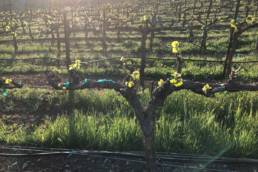FMN – October 2019 – Emilio Bulfon – Ancient Italian Varieties Reborn
I have always fed my geeky wine side by locating and tasting obscure varieties or ones experimentally grown in new and differing locations. With much of the wine world seemingly moving toward monoculture, the popular demand rests on a mere handful of varieties. Many ‘old world’ wine areas have grubbed up indigenous varieties in exchange for varieties that are globally recognized by consumers; so finding these gems have become much more difficult. Sadly, many wines enjoyed hundreds of years ago have been lost due to this lack of appreciation and preservation.
Lucky for us there are some champions of history and conservancy that go to great lengths to not only protect these varieties but dare to make great wines from them. One such producer, Emilio Bulfon, may not be a household name in America but gained infamy in Friuli, Italy for locating and reviving ancient Friulan grape varieties.
The journey began for Bulfon in the 1970s, a time when Italy was just becoming relevant in the international market. As many producers were attempting to chase the ever-changing desires of consumers, Bulfon kept his vision of staying true to his region and his beliefs that their native varieties would one day be appreciated.
With the assistance from the Experimental Institute for Viticulture in Conegliano and expert ampelographers (grape genetic geeks), he has located, replanted, and nurtured these historic vines with great success. Interestingly enough, the discovery of the vines varied from forgotten hillsides growing wild and unattended to sharing space alongside well known varieties in established vineyards as part of a ‘field blend’. They now are finding their lost glory that has gone unrealized for centuries.
Cividin is one such variety in Bulfon’s repertoire and written mention of this grape can be traced back to the seventeenth century. Believed to be named for the municipality Cividale, the scarcity of this white variety cannot be understated with only a couple of producers in the world making a varietal wine. These acidic spicy wines emulate Northern Italy but offer a uniqueness compared to other regional white wines.
Cianoros (Cjanorie), another ancient variety added to the Italian grape registry in 2006 thanks to the work of Bulfon, can be traced back a few hundred years to the Udine province in Friuli. Once highly sought after by eighteenth century nobles for the delicate, light alcohol, pink wines made from this variety at that time, fell out of favor when dark inky wines became all the rage. The lighter color comes from the lower amount of anthocyanins (compounds responsible for skin color). Today we understand that this lighter variety produces overt aromatics due to high concentrations of benzenoid and norisoprenoid at lower terpene levels (for my organic chemistry brethren).
The grape named Piculit Neri literally means ‘small black’, giving reference to its small black berries (in actuality blue/black). One interesting characteristic is a cotton-like bloom that appears on the skins in the spring. The wines made from this grape are usually a small fraction of a blend rather than varietal wine but with his expertise, Bulfon makes it work. Recently proven by genetic testing, this variety remains unrelated to the Picolit used to make sweet white wines of Friuli but hails from the same area.
It is understandable that producers relinquish indigenous varieties for ‘international’ varieties due to consumer recognition. It’s difficult enough to navigate the wine store shelves without having to understand hundreds of obscure grapes as well. Most of the time, these wines will get passed by for a grape or brand that the consumer feels some level of comfort with.
Therefore it is up to the wine gatekeepers to further the cause by introducing these amazing historical significant wines to you the consumer. I would never ask you to drink bad wine for its historic significance only, but if the wines are good, well-priced and convey a legacy, one quickly runs out of excuses not to buy them.
Whether you are planning an Italian themed dinner party, interested in geeky obscure varieties or just looking for something out of the norm, these wines do not disappoint. I tip my hat to producers like Bulfon for keeping these bits of history alive for us to enjoy.
Blanc di San Zuàn, Emilio Bulfon $22
The pale straw color gives way to a nose of ripe tropical fruit, bruised apple, fresh leafy herbs, and a slightly spearmint (conveying an overwhelming freshness). The palate is dry, with medium plus citric acidity that fools our perception due to a medium plus body. Flavors of baked pineapple, mineral and saline notes end in a slightly bitter nut finish. Pair with Clams Casino, Oysters Rockefeller, Carbonara sauce or creamy cheeses like brie, or your next Roman toga party.
Cianoros (Cjanoros), Emilio Bulfon $22
One first notices the ‘fruitness’ of this wine, in a positive way (like Beaujolais Cru but different). The nose has raspberry, red currant, brambles, dried herbs and spice (white pepper). A light, dry palate opens with medium plus acidity, well balanced alcohol, with a tannin component that finally unveils itself toward the finish as fine-grained in nature. This is what people refer to as a ‘sip-able’ wine. Pair this easy drinking wine with pork tenderloin with red-berry sauce, cured meats, or with thoughtless disregard.
Piculit Neri delle Venezie, Emilio Bulfon $22
The nose emulates red fruit (raspberry), blackberry, hazelnut and sweet spice. The palate has a slight off-dry perception with bright mouth-watering acidity, medium body and fine-grained, silky integrated tannin structure that emerges on the finish. Pair this wine with grilled Italian sausage (not too spicy), wild boar, Bolognese made with game or the traditional Friulan dish, Cjarsons.




